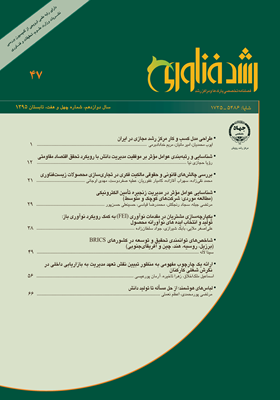شاخصهای توانمندی تحقيق و توسعه در كشورهاي BRICS (برزيل، روسيه، هند، چين و آفريقايجنوبي)
محورهای موضوعی : مديريت تکنولوژي
1 - دانشگاه آزاد اسلامی واحد تهران مرکزی
کلید واژه: شاخص تحقیق و توسعه توانمندیهای تحقیق و توسعه کشورهای بریکس سیاستهای توسعه,
چکیده مقاله :
امروزه تحقيق و توسعه و فعاليتهاي مرتبط با دستيابي به فناوريهاي جديد در سراسر دنيا يک فعاليت عمده صنعتي محسوب میگردد. عليرغم اينکه تحقيق و توسعه صنعتي در کشورهاي توسعهيافته در سي سال گذشته، از اهميت فزایندهای برخوردار بوده است، در عين حال کشورهاي در حال توسعه به تازگي به اهميت آن پي بردهاند. فناوري محصولي است که در کارخانه تحقيق و توسعه بهوجود ميآيد و واحدهاي تحقيق و توسعه، رکن زيربناي فناوري دانسته شده و بزرگترين منبع يگانه نوآوري، تحقيق و توسعه هستند. براي دستيابي به فناوري، روشهاي گوناگوني وجود دارد که يکي از مهمترين آنها (به ویژه در کشورهاي در حال توسعه)، مهندسي معکوس است. در اين مقاله ضمن مرور پيشينه "تحقيق و توسعه" و بررسی عوامل مؤثر بر توانمندیهای آن، اقدام به بررسی تجارب کشورهای پیشتاز در این عرصه شده است. در این بین مطالعه موردی حول محور کشورهای بریکس انجام شده، به نحوی که توانمندیها و مؤلفههای کلیدی که در این کشور ها لحاظ شده است اقتباس گردیده و براساس آنها نسبت به تدوین یک مدل مفهومی به منظور ارزیابی توانمندی تحقیق و توسعه، اقدام شده است. در نهایت نیز ضمن اشاره به مشکلات موجود در توسعه و رشد توانمندسازی تحقیق و توسعه در ایران، راهکارهایی به منظور کاهش این موانع و ارتقاء سطح کمی و کیفی توانمندی تحقیق و توسعه ارائه شده است.
Today, research and development and related activities in order to access the modern technology is major industrial activity in the world. Despite the increasing importance of research and development activities in developed countries in the last thirty years, developing countries have recently realized its integral importance. Actually, technology is an output of the research and development factory.The research and development units are infrastructure of technology and the greatest source of innovation. There are Various procedure to achive technology that reverse engineering is one of the most important. (especially in developing countries) In this essay, addition to review the literature of "research and development" and the factors affecting its capabilities, experiences of leading countries in this field (BRICS) will be checked in order to design a conceptual model to assess the research and development capabilities. In the end, we present some pieces of advice to reduce the problems and increase the quality and quantity level of R&D.
1- آراستی، محمدرضا، همکاران. شناسایی عوامل مؤثر بر ظرفیت نوآوري بنگاههاي اقتصادي: مطالعه موردي شرکتهاي اتوماسیون صنعتی ایران، 2009.#
2- بوشهری، علیرضا، همکاران، ارزیابی توانمندی تحقیق و توسعه؛ انتشارات مؤسسه آموزشی و تحقیقات دفاعی، 2008.#
3- Afuah, A; Innovation Management: Strategies, Implementation, and Profits; Oxford University Press, 2011.#
4- Boly, V., Morel, L., & Renaud, J. (2013). Towards a Constructivist Approach to Technological Innovation Management: An Overview of the Phenomena in French SME’s. in International Handbook on Innovation, Elsevier, 2003.#
5- Khalil, T. (2007). Management of Technology: The Key to Competitiveness and Wealth Creation. McGraw-Hill#
6- Microsoft Corporation,2014,White Paper Innovation Process Management,2014#
7- Morel, L., & Boly, V. (2010). Innovation process evaluation: From self assessment to detailed technological audit.#
8- Tidd, Joe; John Bessant; Keith Pavitt;(2012),Managing Innovation Integrating Technological Market, and Organizational Change; John Wiley & Sons, 2012#
9- Cebon, Peter; Peter Newton; Philip Noble;(2005) Innovation In Frims – Towards a Model for indicator development; Melborn Business School Working Paper 99-9, 2005.#


